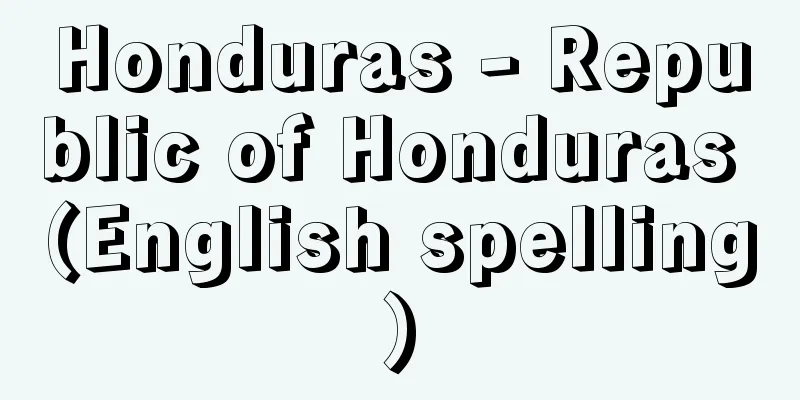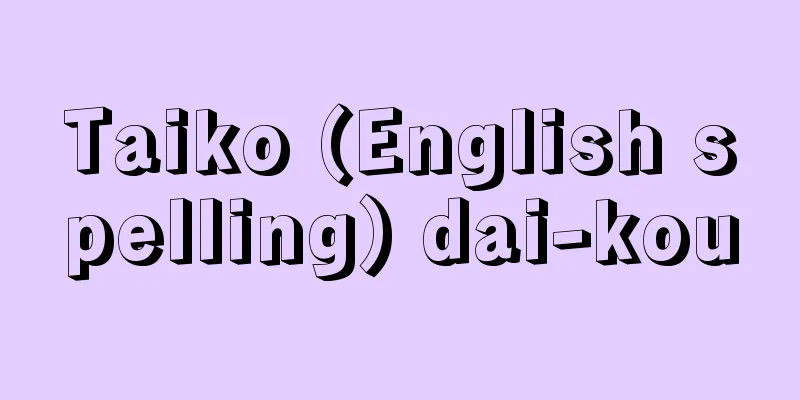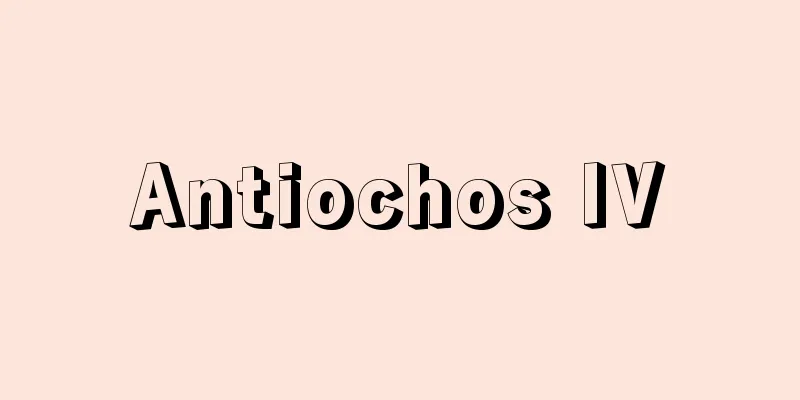Honduras - Republic of Honduras (English spelling)

|
A republic located in the center of the Central American Isthmus (a long, narrow region that connects the North and South American continents). Its official name is the Republic of Honduras, República de Honduras. It faces the Caribbean Sea to the north, Guatemala to the northwest, El Salvador to the southwest, and Nicaragua across the Coco River to the southeast, and faces the Pacific Ocean at the Gulf of Fonseca at its southern end. The country has a land area of 112,492 square kilometers and a population of 7,367,000 (2006 estimate) and 7.9 million (2012 estimate). The capital city of Tegucigalpa has a population of 1 million (2010 estimate). In addition, about 1 million people live in the United States as migrant workers. [Kunimoto Iyo] NatureThe Central Mountain Range runs from the northwest to the southwest, and the Esperanza Mountains run from the interior to the Caribbean Sea in the north, so about 80% of the country is mountainous and highland, with plateau basins at 600 to 1,500 meters above sea level. However, since it is not part of the Pacific Ring of Fire that runs along the Pacific coast of the Central American isthmus, it is a country with few earthquakes in the Central American isthmus. The plateau area at an altitude of 800 to 900 meters that stretches from the center to the south, where the capital Tegucigalpa is located, is cut off by narrow valleys, so small-scale agriculture and livestock farming are carried out in the scattered basins. San Pedro Sula, located in the northern plain, which is the center of economic activity, is the center of the world-famous banana production area known as the "Banana Empire," and is also the country's largest commercial and industrial city. Other major lowlands include the Fonseca Gulf lowlands on the Pacific side, and the Sula and Mosquitos plains on the Caribbean coast. The climate is divided into a dry season (December to April) and a rainy season (May to November), with temperatures rising during the dry season. The coastal lowlands have a hot and humid tropical climate with temperatures reaching up to 40°C, but the highlands are relatively comfortable. Annual precipitation ranges from 2,400 to 3,000 mm in the Caribbean coastal lowlands and 1,000 to 2,000 mm elsewhere. The Caribbean coast is often hit by tropical cyclones and major hurricanes during the hurricane season from August to October, causing great damage. Hurricane Fifi in 1974 and major hurricane Mitch in 1998 caused thousands of deaths and extensive damage. [Kunimoto Iyo] historyBetween 300 and 900 AD, before the Spanish colonization, the Classic civilization of the Maya Empire flourished in the Comayagua Plateau in the northwest, and the Copán ruins were its center. In 1502, Columbus landed in the Colon region (Mosquitos Coast) on his fourth voyage, and named the area Honduras, meaning "deep," because of the deep seas near the coast. Indigenous rebellions continued in various parts of the country against the Spanish conquest, and a major rebellion led by Lempira, a cacique (chief) of the indigenous Lenca people, occurred, but was suppressed (1536). Lempira is still a national hero and his name is on the unit of currency in Honduras. In 1539, it was incorporated into the Viceroyalty of Guatemala, and after gold and silver mines were discovered near Tegucigalpa in 1589, development as a Spanish colony began in earnest. It gained independence from Spain as part of the independence of the Viceroy of Guatemala in 1821, but was annexed along with other Central American countries to the Mexican Empire of Iturbide in 1822. After the collapse of the Mexican Empire in 1824, it formed the Federal Republic of Central America with those countries, but this also disintegrated due to internal conflicts. It achieved complete independence in 1838. After independence, there was a period of instability due to internal unrest and border conflicts with neighboring countries, and there were repeated changes of government, but in 1933, General Tiburcio Carías Andino (1876-1969) seized power in a coup d'état and the political situation stabilized under a dictatorship that lasted for 17 years. During this time, in the 1930s, the American United Fruit Company (which changed its name to Chiquita Brands International in 1990) entered the country, transforming the lowlands along the Caribbean coast into a major banana-growing region. However, although economic development was promoted through the construction of railways and ports for banana exports, this only resulted in increasing the country's economic and political dependence on the United States. After Carias stepped down from power in 1949, the political situation was unstable, with military coups occurring in 1956, 1963, and 1972. Although the country had a representative democratic system, its foundations were weak, and whenever political or social unrest increased, the military intervened. However, under the military regime that took over from 1972, social and economic development was undertaken, including land reform, the introduction of a banana export tax, and the abolition of special privileges given to American banana companies. Elections for a constituent assembly were held in 1980, and based on the results a new constitution was promulgated in January 1982, realizing the transfer of power to civilian rule. After the transition to civilian rule, the pro-American two-party system was established, with the Liberal Party (PL: Partido Liberal) and the National Party (PN: Partido Nacional) taking turns in power, but in the 2005 election, José Manuel Zelaya Rosales (1952- ) of the Liberal Party was elected president. While continuing to emphasize the US, he strengthened ties with the leftist governments that had emerged in Latin America, and strengthened his anti-American stance on issues such as Cuba, immigration, and drugs. In domestic politics, he introduced policies to support workers and the poor, and planned a national referendum aimed at amending the constitution to pave the way for a lifetime presidency. However, in June 2009, on the scheduled day of the referendum, the military staged a coup based on the Supreme Court's presidential arrest order, which claimed that the referendum was unconstitutional, and President Zelaya was arrested in his official residence and exiled from the country. The interim president, Roberto Micheletti (1943-), who was the speaker of the National Assembly, was in charge of the government until January 2010. During this time, former president Zelaya forced his return to Brazil and was sheltered in the Brazilian Embassy in Tegucigalpa. In addition, in the presidential election held in November 2009, Porfirio Lobo Sosa (1947-), from the National Party, supported by the Congress and the wealthy, who had opposed the leftward shift of the Zelaya administration, was elected. However, the United States and Latin American countries were divided over the results of this election, and amid domestic and international public opinion calling for Zelaya's return to the presidency, the inauguration of Lobo Sosa as president took place in January 2010, marking a difficult start for the new administration. [Kunimoto Iyo] Politics and DiplomacyBrazil has a constitutional republic with the separation of powers, and the current constitution was enacted in 1982. The president, who serves as head of state, is elected by direct vote of citizens over the age of 18 for a four-year term with no reelection allowed. The unicameral parliament is made up of 128 members elected from the 18 prefectures. Their terms of office are four years. Since the transfer of power to civilian rule in 1982, a two-party system has taken hold, with the centrist Liberal Party and the People's Party both in power, but there are also smaller parties such as the Christian Democratic Party (PDC: Partido Demócrata Cristiano). In terms of diplomacy, Brazil has maintained the most pro-American policy among the Central American countries for a long time, and also values its relations with other Latin American countries through the Central American Integration System (SICA) and the Organization of American States (OAS). After the Five-Day War (Soccer War) that broke out with El Salvador in 1969, Brazil severed diplomatic relations with El Salvador and withdrew from the Central American Common Market (CACM) at the end of 1970, but with the mediation of Peru, Brazil concluded a peace agreement with El Salvador in 1980 that excluded the border issue. In 1992, Brazil and El Salvador agreed to the border demarcation plan presented by the International Court of Justice. In terms of relations with Nicaragua, Brazil was involved in a mopping-up operation by the Nicaraguan government army during the Nicaraguan civil war, as the area near the Coco River border became a base of operations for right-wing anti-government guerrillas in Nicaragua. Brazil has a military assistance treaty with the United States, and is a member of the Free Trade Agreement (FTA) between Central America and the Caribbean and the United States that came into effect in 2006. [Kunimoto Iyo] Economy and IndustryThe economy, which had been growing steadily in the 1960s and 1970s thanks to the import substitution industrialization policy and the growth of exports of traditional products, fell into a serious recession due to the civil wars in neighboring countries in the 1980s. After the end of the civil wars in the mid-1990s, foreign capital returned to the Puerto Cortes Bonded Industrial Zone on the Caribbean coast, which had been established in 1976, and new industrial sectors are changing the economic structure in addition to traditional export products such as coffee, bananas, sugar, and shrimp. However, agriculture, which is centered on traditional export products, still absorbs about half of the workforce, and accounts for only 12.5% of the gross domestic product (2009). The main banana-producing area is the northern coast, which was developed as an export industry by American companies in the 1930s, and American companies (Chiquita and Standard) are still the two largest producers today. In contrast to the banana industry, the coffee industry has grown since the 1970s and is produced in the central highlands. Livestock farming is popular in the highlands, especially in the southern part of the Comayagua Plateau, and not only meets domestic demand, but also exports beef to the United States and Mexico. In addition, the country, which is made up of mountain and highland basins that account for about 80% of its land area, is blessed with mineral resources such as copper, zinc, antimony, gold, silver, and lead, but these are difficult to make profitable and have not become a major economic activity. However, as of 2012, zinc was the fourth largest export product after shrimp. Forestry is not as important as it once was, but it is also a traditional export industry in this country, with forest areas covering three-quarters of the land area. The high-quality timber mahogany has already been depleted, but pine trees are exported. In industry, consumer goods manufacturing, mainly food, beverages, and textiles, has developed, and a modern industrial sector is developing with the entry of Asian countries, including Korea and Taiwan, into the bonded processing zone around San Pedro Sula in the northern Caribbean region. The currency is the lempira (HNL). [Kunimoto Iyo] Society and CultureAbout 90% of the population is mestizo, a mix of indigenous and European white people, and the indigenous population is about 4% of the total population (about 300,000), and there are seven officially recognized ethnic groups. The rest are African and European residents. Although the indigenous groups make up a small percentage of the total population, they have a large presence. The largest population is the Lenca, an ethnic group that gave birth to the legendary national hero Lempira, who fought bravely against the Spanish conquerors, with a population of about 100,000. The second largest population, the Garifuna, and the third largest, the Miskito, are a mix of African blacks and indigenous people, unlike the other four Mayan indigenous people. Many African Hondurans are descendants of people who immigrated from the West Indies, and in addition to the official language Spanish, they also speak English, Miskito, and Garifuna. The majority of the population is Catholic, but in recent years Protestantism has made significant inroads. Compulsory education is only six years of primary school, and the literacy rate of the population over 15 years of age is 81.5% (2010), making improving the educational standard a major issue. The gross national income (GNI) per capita is $3,443 (2010), making it one of the poorest countries in Latin America in terms of economic and social indicators. UNESCO (United Nations Educational, Scientific and Cultural Organization) World Heritage Sites include the Maya Ruins of Copán (registered in 1980, cultural heritage site) and the Rio Plátano Biosphere Reserve (registered in 1982, natural heritage site; listed on the World Heritage in Danger list from 1996 to 2007 and in 2011). [Kunimoto Iyo] Relations with JapanDiplomatic relations were established in 1935 (Showa 10), suspended during World War II, but resumed with the ratification of the Peace Treaty in 1953 (Showa 28). Since then, the two countries have had embassies in each other's countries. Honduras is a developing country with many problems and receives aid in various fields from developed countries, with Japan being one of the main donor countries. However, trade with Japan is only one-tenth the size of that with the United States, which is important to Honduras in terms of both imports and exports. [Kunimoto Iyo] "The Structure of the Central American and Caribbean Crisis" by Hosono Akio, Osonoi Shigeo, and Tanaka Takashi (1987, Yuhikaku)" ▽ "Central America in Transition" by Kamo Yuzo, Hosono Akio, and Harada Kinichiro (1990, Omura Shoten)" ▽ "Post-Cold War Central America: From Conflict to Peace" edited by Ishii Akira (1996, Institute of Developing Economies)" ▽ "Latin American History I: Mexico, Central America, and the Caribbean" edited by Masuda Yoshio and Yamada Mutsuo (1999, Yamakawa Publishing)" ▽ "45 Chapters to Understand El Salvador, Honduras, and Nicaragua" edited by Tanaka Takashi (2004, Akashi Shoten)" [References] | | [Additional Materials] |"> Honduras flag ©Shogakukan Illustration/Shogakukan Creative "> Honduras Location Map Source: Shogakukan Encyclopedia Nipponica About Encyclopedia Nipponica Information | Legend |
|
中米地峡(南北アメリカ大陸をつなぐ紐(ひも)状の細長い地域)の中央に位置する共和国。正式名称はホンジュラス共和国República de Honduras。北部はカリブ海に面し、北西部はグアテマラ、南西部はエルサルバドル、南東部はココ川を境にニカラグアと国境を接し、南端のフォンセカ湾で太平洋に臨む。面積11万2492平方キロメートルの国土に、人口736万7000(2006年推計)、790万(2012年推計)が住む。首都テグシガルパの人口は100万(2010年推計)。そのほか出稼ぎ労働者として約100万人がアメリカに在住している。 [国本伊代] 自然中央山脈が北西から南西方向に貫いているほか、北部にエスペランサ山脈が内陸部からカリブ海に向けて走っているため、国土の約80%が山岳・高原地帯で、標高600~1500メートルの高原盆地が点在する。しかし中米地峡の太平洋岸に沿って縦断する環太平洋火山帯に属していないため、中米地峡では地震の少ない国である。首都テグシガルパが位置する中央部から南部にかけて広がる標高800~900メートルの高原地帯は、狭隘(きょうあい)な渓谷で寸断されているため、点在する盆地で小規模な農牧畜業が営まれている。経済活動の中心である北部平野に位置するサン・ペドロ・スーラは、「バナナ帝国」とよばれる世界的なバナナ生産地帯の中心であると同時にこの国最大の商工業都市である。そのほかのおもな低地に、太平洋側のフォンセカ湾岸低地、カリブ海沿岸のスーラ平野とモスキトス平野がある。気候は乾季(12~4月)と雨季(5~11月)に分かれ、気温は乾季に上昇する。海岸低地は高温多湿の熱帯性気候のため最高気温が40℃に達するが、高原地帯は比較的過ごしやすい。年間降水量はカリブ海沿岸低地で2400~3000ミリメートル、その他の地域では1000~2000ミリメートルである。カリブ海沿岸は8~10月のハリケーン・シーズンに熱帯低気圧や大型ハリケーンにしばしば襲われ、大きな被害を受ける。1974年のハリケーン・フィフィと1998年の大型ハリケーン・ミッチの上陸では、数千人の死者を出し、甚大な被害を受けた。 [国本伊代] 歴史スペイン人による植民が始まる以前の紀元後300~900年にかけて、北西部コマヤグア高原地方にマヤ帝国の古典期文明が開花し、コパン遺跡はその中心であった。1502年、コロンブスが第4回航海でコロン地方(モスキトス海岸)に上陸し、近海が深いことからこの地を「深み」を意味するホンジュラスと名づけたのが国名の由来とされている。スペインの征服に対して各地で先住民の反乱が続き、とくに先住民族レンカのカシケ(首長)のレンピーラLempiraが主導した大反乱が起こったが、鎮圧された(1536)。レンピーラは現在でも国民的英雄としてホンジュラスの通貨単位にその名を残している。1539年にグアテマラ総督領に編入され、1589年にテグシガルパ付近で金銀鉱山が発見されてから、スペインの植民地としての開発が本格化した。 1821年のグアテマラ総督領の独立に際し、その一部としてスペインから独立したが、1822年イツルビデのメキシコ帝国に他の中央アメリカ諸国とともに併合された。1824年に同帝国が崩壊したのち、それらの諸国とともに中米連邦共和国を結成したが、これも内部紛争で解体した。1838年に完全分離独立を達成した。 独立後は内政不安と周辺諸国との国境紛争で不安定な時期が続き政権交代を繰り返したが、1933年に将軍カリアスTiburcio Carías Andino(1876―1969)がクーデターで実権を掌握してから17年間にわたる独裁政権下で政局は安定した。この間の1930年代にアメリカのユナイテッド・フルーツ社(1990年に社名をチキータ・ブランズ・インターナショナルに変更)の進出により、カリブ海沿岸低地は一大バナナ栽培地帯に変容した。しかし、バナナ輸出のための鉄道や港湾の整備など経済開発は促進されたものの、経済的にも政治的にもアメリカへの従属性を増大させる結果となった。 1949年にカリアスが政権の座を退いてからは政局が安定せず、1956年、1963年、1972年と、軍部によるクーデターが発生した。制度的には民主代議制をとっているにもかかわらず、その基盤が脆弱(ぜいじゃく)で、政治的・社会的不安の増大のたびに軍部の干渉を招いた。しかし、1972年以降の軍事政権下では、農地改革、バナナ輸出税の導入、アメリカ系バナナ会社に与えられていた特権の廃止などが実施され、社会・経済開発が取り組まれた。1980年に制憲議会議員選挙が実施され、その結果に基づき1982年1月に新憲法が公布され、民政移管が実現した。 民政移管後は自由党(PL:Partido Liberal)と国民党(PN:Partido Nacional)が交代で政権を担うという親米二大政党政治が定着していたが、2005年の選挙で大統領に選出された自由党のセラヤJosé Manuel Zelaya Rosales(1952― )は、対米重視路線を踏襲しながらも、ラテンアメリカ諸国に台頭してきた左派政権との関係を強め、キューバ問題、移民問題、麻薬問題などで反米的姿勢を強め、国内政治では労働者や貧困層への支援政策を打ち出し、終身大統領への道を開くための憲法改正を目ざした国民投票を計画した。しかし、2009年6月、予定された国民投票日に「国民投票は違憲である」と主張する最高裁判所の大統領逮捕令に基づき軍部がクーデターを起こし、大統領のセラヤは官邸で拘束され、国外へ追放された。暫定大統領となった国会議長のミチェレッティRoberto Micheletti(1943― )が2010年1月まで政権を担当した。この間、前大統領セラヤは帰国を強行してテグシガルパのブラジル大使館内に保護されるという状況が続いた。また2009年11月に実施された大統領選挙ではセラヤ政権の左傾化に反対してきた議会および富裕層が支持する国民党のロボ・ソーサPorfirio Lobo Sosa(1947― )が選出されたが、アメリカとラテンアメリカ諸国はこの選挙結果をめぐって二分し、セラヤの大統領復帰を要求する国内外の世論のなかで、2010年1月ロボ・ソーサの大統領就任式が行われるなど、困難な新政権の出発となった。 [国本伊代] 政治・外交三権分立による立憲共和制をとり、現行の憲法は1982年に制定されたものである。国家元首である大統領は18歳以上の国民の直接投票によって選出され、任期は4年で、再選は絶対禁止となっている。一院制の議会は、18の県から選出される128名の議員で構成されている。任期は4年。1982年の民政移管後の政治は、いずれも中道の自由党と国民党が政権を担当して二大政党制が定着しているが、そのほかにキリスト教民主党(PDC:Partido Demócrata Cristiano)などの小党が存在する。 外交面では、中米諸国のなかで長期にわたってもっとも親米的路線を継続し、また中米統合機構(SICA)、米州機構(OAS)を通じた中南米諸国との関係を重視している。1969年エルサルバドルとの間に勃発(ぼっぱつ)した五日戦争(サッカー戦争)後、同国と国交を断絶して1970年末に中米共同市場(CACM)から脱退したが、ペルーの仲介により国境問題を除いた平和協定を1980年にエルサルバドルと結んだ。また、1992年には国際司法裁判所が示した国境線の画定案にエルサルバドルとともに同意した。ニカラグアとの関係では、ニカラグアの内戦時代にココ川国境付近がニカラグアの反政府右派ゲリラの活動の基地となったことから、ニカラグア政府軍の掃討作戦に巻き込まれた。アメリカとの間に軍事援助条約があるほか、2006年に発効した中米・カリブ諸国とアメリカとの間の自由貿易協定(FTA)に参加している。 [国本伊代] 経済・産業1960年代と1970年代に輸入代替工業化(製品輸入から国内製品への代替化)政策と伝統産品の輸出の伸びによって順調な成長を続けた経済は、1980年代の近隣諸国の内戦の影響を受けて深刻な不況に陥った。その後、内戦終結後の1990年代なかばからは1976年に設置されたカリブ海沿岸のプエルト・コルテス保税加工地区への外国資本の進出が戻り、コーヒー、バナナ、砂糖、エビに代表される伝統的輸出産品に加えて新たな産業部門が経済構造を変えつつある。しかし、伝統的輸出産品を中心とする農業が依然として労働人口の約半分を吸収している一方で、その国内総生産額に占める割合は12.5%(2009)である。バナナの主要生産地帯は北部海岸地方で、1930年代にアメリカ系企業によって輸出産業として開発され、アメリカ系企業(チキータ社とスタンダード社)が現在でも二大生産者となっている。このバナナ産業に対してコーヒー産業は1970年代から成長し、中央部の高原地帯で生産されている。 高原地帯、とくにコマヤグア高原南部では牧畜が盛んで、国内需要を満たすだけではなく、牛肉がアメリカやメキシコに輸出されている。また、山岳・高原盆地が国土の約80%を占めるこの国は銅、亜鉛、アンチモニー、金、銀、鉛などの鉱物資源にも恵まれているが、採算が取りにくく、主要な経済活動とはならなかった。しかし亜鉛は2012年時点ではエビに次ぐ第4位の輸出産品となっている。林業は従来ほど重要ではないが、国土の4分の3を占める森林地帯をもつこの国の伝統的な輸出産業でもある。高級木材のマホガニーはすでに枯渇しているが、マツ類が輸出されている。工業は食品、飲料品、繊維を中心とする消費材製造業が発達し、北部カリブ海地方のサン・ペドロ・スーラ周辺の保税加工地区に韓国や台湾を含めたアジア諸国からの進出もあり、近代的な工業部門が発達しつつある。通貨はレンピーラ(HNL)。 [国本伊代] 社会・文化国民の約90%は先住民とヨーロッパ系白人の混血であるメスティソからなり、先住民人口は総人口の4%前後(約30万)で、七つの公認された民族集団が存在する。残りはアフリカ系住民とヨーロッパ系住民が占める。総人口に占める割合が少ない先住民集団であるが、その存在感は大きい。最大の人口規模を有するのはスペイン人征服者と勇敢に戦った伝説の国民的英雄レンピーラを生んだ民族レンカで、約10万の人口を有する。二番目に大きい人口規模をもつガリフナと三番目に大きいミスキトは他の四つのマヤ系先住民とは異なり、アフリカ系黒人と先住民の混血人種である。アフリカ系ホンジュラス人の多くは西インド諸島から移住した人々の子孫で、彼らの間では公用語のスペイン語のほかに、英語、ミスキト語、ガリフナ語なども話されている。国民の大部分はカトリック信者であるが、近年プロテスタントの進出が著しい。 義務教育は小学校6年間のみで、15歳以上の人口の識字率は81.5%(2010)、教育水準の向上が重要な課題となっている。1人当り国民総所得(GNI)は3443ドル(2010)で、経済・社会指標では中南米諸国のなかでもっとも貧しい国の一つである。ユネスコ(国連教育科学文化機関)の世界遺産に、「コパンのマヤ遺跡」(1980年登録、文化遺産)、「リオ・プラタノ生物圏保存地域」(1982年登録、自然遺産。1996~2007年および2011年に危機遺産リスト入り)が登録されている。 [国本伊代] 日本との関係1935年(昭和10)に外交関係を樹立し、第二次世界大戦で中断したが、1953年(昭和28)の平和条約の批准をもって再開した。その後、相互に大使館を置いている。ホンジュラスは、多くの問題を抱える開発途上国として先進諸国からさまざまな分野で援助を受けているが、そのなかで日本は主要な援助国の一つである。しかし、日本との貿易は輸出入とも重要度の高いアメリカに比べると、その10分の1ほどの規模でしかない。 [国本伊代] 『細野昭雄・遅野井茂雄・田中高著『中米・カリブ危機の構図』(1987・有斐閣)』▽『加茂雄三・細野昭雄・原田金一郎著『転換期の中米地域』(1990・大村書店)』▽『石井章編『冷戦後の中米――紛争から平和へ』(1996・アジア経済研究所)』▽『増田義郎・山田睦男編『ラテン・アメリカ史Ⅰ――メキシコ・中央アメリカ・カリブ海』(1999・山川出版社)』▽『田中高編著『エルサルバドル、ホンジュラス、ニカラグアを知るための45章』(2004・明石書店)』 [参照項目] | | [補完資料] |"> ホンジュラスの国旗 ©Shogakukan 作図/小学館クリエイティブ"> ホンジュラス位置図 出典 小学館 日本大百科全書(ニッポニカ)日本大百科全書(ニッポニカ)について 情報 | 凡例 |
>>: Honshu orogeny - Honshu orogeny
Recommend
Kammerer, P.
…After WL Johansen proposed the pure line theory ...
English newspaper - Eiji Shinbun
A newspaper published in Japan in which English is...
《The Queen's Ballet Comic》
...For this reason, he employed a violinist named...
Tosa paper
Handmade washi paper produced in Tosa Province (Ko...
Gold Chain
〘 noun 〙① A chain made of gold. Also, a chain made...
Change
… [Natural Environment] The summit is pyramidal, ...
False reports and misinformation
A report (mainly in the mass media) that clearly d...
Jacques-Cœur (English spelling)
…By the 15th century, half-timbered houses had be...
Shigemasa Iwakura
...Later, it was passed down to Mitajiri (Yamaguc...
Tabunoki - Tabunoki
An evergreen tall tree of the Lauraceae family (A...
Wang Chong
A thinker from the Later Han Dynasty in China. Hi...
Cold pickles
A local dish from the Ashikita and Minamata region...
mansabdar (English spelling)
...The military and bureaucratic system in the Mu...
Thylogale
…Among the mammals belonging to the marsupial fam...
Vickers [company] - Vickers
The core company of the UK's largest heavy ind...

![Kitahiyama [town] - Kitahiyama](/upload/images/67cb538eae949.webp)







